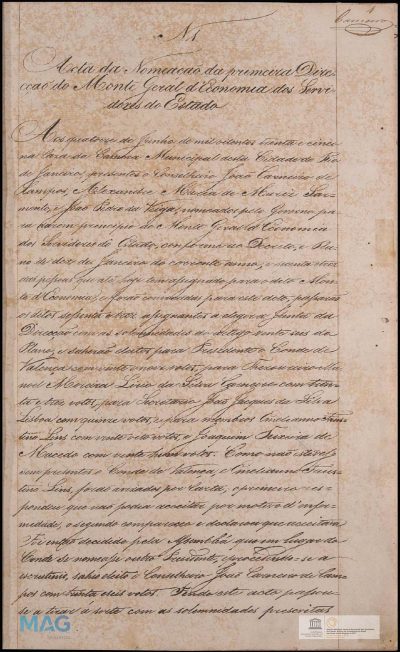In May, the Brazilian museum community celebrated the 21st National Week of Museums. We joined up with the programme and partnered with Memória MAG Seguros. This article, by Alberto Machado, is about the digitised archives of the Montepio Geral de Economia dos Servidores do Estado. To find out more, please read on.
MAG Seguros the beginning of social security in Brazil
The Montepio Geral de Economia dos Servidores do Estado (General Savings and Loans Fund for State Employees) was the first Brazilian social security institution with an official and organised legal basis. Its creation followed a decree from the Regency Trina that governed the country on behalf of Pedro de Alcântara, son and successor of Pedro I, emperor of the brand-new Brazilian Empire.
In its early years as an independent nation, Brazil was experiencing an extremely turbulent time marked by regional revolts, political struggles, and uncertainties about the future. In this scenario, the basis for the constitution of a non-profit organisation that could protect the relatives of all public servants of the Empire, was approved by a government decree on 10th January, 1835, in the country’s administrative headquarters, the second floor of the Palace of the City of Rio de Janeiro.
The documentary collection presented gathers the Minutes of the Management Board of the Montepio Geral de Economia dos Servidores do Estado, with emphasis on the election of its first Board of Directors on 14th June 1835. The minutes range from the year of its foundation to 1977.
These historical documents comprise:
- the sessions of the Board of Directors
- sessions of the Board with State Ministers
- how the collections for the fund began
- how money remittances should be made, the requests for participation in lotteries to raise funds and how it was done
- the first registered public employees
- admissions of new civil servants (with all the information of who was requesting)
- requests for benefits increases (pensions benefits)
- granted pensions (list of all pensions granted – with information about applicants and employees)
- elections of presidents and members (number of votes and voters)
- decrees’ amendments
- decisions on various matters that were presented at that time.
The gallery of Montepio’s presidents includes people who are recognised as important to the country, such as Aureliano de Sousa e Oliveira Coutinho (the Viscount of Sepetiba) from 1837 to 1843, Pedro de Araújo Lima (the Viscount of Olinda) from 1851 to 1853, Manuel Vieira Tosta (the Baron of Muritiba) from 1859 to 1861, José Maria da Silva Paranhos (the Viscount of Rio Branco) from 1871 to 1881, and João Lustosa da Cunha (the Viscount of Paranaguá) from 1881 to 1901, among others.
The documents illustrate the construction and development of social security in Brazil over 142 years (1835 to 1977). It details the first decisions made, difficulties faced, fraud attempts, and the emergence of a social security project. The importance of the Montepio’s archive can also be measured by the historical context of social security in modern civilisation. In England, retirement systems for employees had been established in the early 1700s. In France, only in September 1885, a law turned assistance funds mandatory. During this period, Germany (1883-1889) enacted laws known as Bismarck’s Laws, a representative landmark in the history of social security. In the New World, the retirement plan for the New York City Police Department, in 1857, can be cited as an example in the United States of America.
This concise chronological summary of the social security evolution highlights the importance of the available archives at Mongeral Aegon Group (MAG Seguros). It is a valuable collection of documents that reveal the history, evolution, establishment of pension plans, and events related to social security. These documents provide a detailed insight into this pioneer initiative in our country.
For all these reasons, this documentation – now available to public consultation and research by the company’s own initiative – was recognised by UNESCO, the United Nations Educational, Scientific, and Cultural Organization, as Documentary Heritage of Humanity through the Memory of the World certificate in October 2017.
Get to know the collection of 43 books of Meeting Minutes, which tell the story of the emergence of social security in Brazil, by clicking on the link https://vida.mag.com.br/atas-historicas/
The International Memory of the World Register recognises documentary heritage of global significance and includes documents such as the Magna Carta. It inspires both nations and regions to identify, list and preserve their respective documentary heritage for the collective memory of humankind. The website is https://www.unesco.org/en/memory-world

First book of the MAG Historical Minutes Collection. The meeting on 14th June 1835 elected the company’s first board of directors. Founded on 10th January 1835, Montepio reached the number of 100 members in June of the same year and that was the requirement to choose the first board through voting.


Memory of the World Register – UNESCO – Brazil
